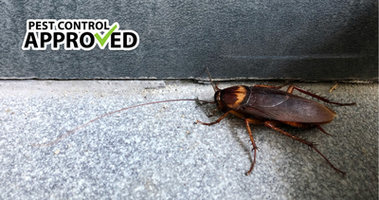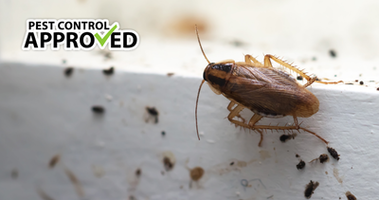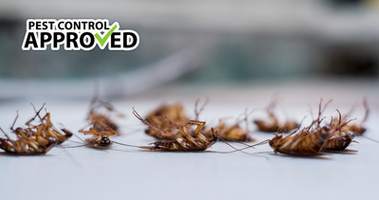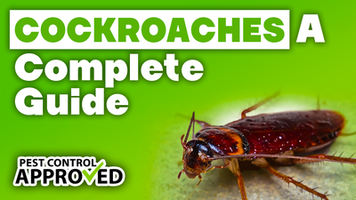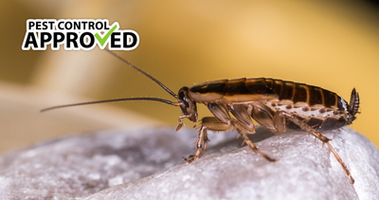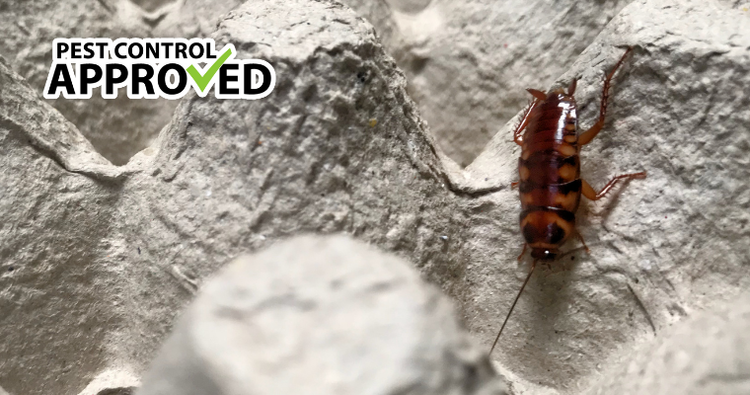
Brown-banded Cockroach
The Brown-banded cockroach is the most well-known cockroach in North America. It is a small invasive species. It was reportedly imported with fruit shipped from Cuba in the early 1900’s. It is a nocturnal species that prefers dry conditions. While most cockroaches live near water, this species will reside in warm, dry areas like attics.
NAME: Supella longipalpa
HABITAT: Residential & Commercial Buildings
DIET: Omnivore
SIZE: 25/64" to 35/64"
PREDATORS: Birds, reptiles
LIFE EXPECTANCY: 4 – 10 months
Size
The brown-banded cockroach is one of the smallest species of cockroach. It is between 25/64" and 35/64" long. It is approximately the size of a penny.
Appearance
The brown-banded cockroach gets its name from two light coloured bands on its wings and abdomen. These bands can be solid or broken up and may be partly obscured by their wings. The band is visible on both adults and cockroach nymphs. The rest of its body is tan or light brown. The brown-banded cockroach has three body sections: the head, the thorax, and the abdomen. The head contains compound eyes, antennae, and mouth parts. The thorax contains their six legs and wings. The male’s wings cover their abdomen while the female’s do not fully cover it. Males also look thinner than females.
Diet
A cockroach’s diet varies wildly depending on what is available. They are opportunistic and will eat insects, wood particles, fungi, and algae. Indoors, they will eat crumbs, pet food, and shed human skin. They tend to prefer high starch foods like book binding material, glue, and stamps. They will eat anything organic and sometimes will eat non-organic material that has human skin or oil residue. They can survive for a month without food and need very little water to survive.
Habitat
Although they are not native to North America, they are habituated to most of the United States. They prefer drier climates than most cockroaches and are thus not found near water sources like faucets or bathtubs. It prefers temperatures between 77⁰F and 91⁰F. They commonly reside in higher locations like cabinets and attics unlike other species which prefer being close to the ground. They live in the warmer areas of the home such as near hot water tanks, light switch plates, and electronics.
Reproduction
Brown-banded cockroaches reproduce quickly. The female cockroach lays a group of eggs in an egg case or capsule. Each egg case contains 10 to 18 eggs. The female will carry this egg case around for about 30 hours until it hardens. Then, she will glue it underneath furniture. The capsules are usually laid near each other in clusters. The capsule or egg case is extremely hard and impermeable to pesticides. It is 1/4 inches long and tan to reddish brown. The capsule and eggs will incubate anywhere between 37 and 103 days depending on the environment. Once hatched, the nymphs will go through several molts over two months before becoming adults. While nymphs have no wings, they are independent and able to move to find food and shelter. The total life cycle from egg to adult takes between 90 and 276 days. One female cockroach will lay around 12 to 16 egg capsules in her lifetime. This total to around 200 eggs in less than a year! Even if you find just one cockroach, it's important to get a treatment right away so it doesn't become a large scale infestation.
Predators
Cockroaches are preyed on by a variety of animals including reptiles, birds, and other insects. Outside North America, hedgehogs are a common predator of cockroaches. In the Southern USA, reptiles are the biggest threat. Toads, frogs, lizards, and geckos are adept at catching and eating cockroaches. However, in parts of the United States, the weather is too cold for many reptiles. Rodents are more likely to eat cockroaches in colder areas. While mice can eat them, rats are known for eating cockroaches. They can even eat them off of glue traps! They are able to skillfully eat them without getting caught in the glue.
In Northern states, the most likely predator of cockroaches are birds. Starlings are large enough to eat cockroaches and need insects to be able to breed. Chickens are also great bug catchers and can eat lots of cockroaches if given the opportunity.
Parasitic wasps are known to lay their eggs inside the cockroach egg capsule. The newly hatched wasps will eat either the young larva or eat the nourishing egg fluids, starving the cockroach larva. The exact nature of these wasps depends on the species.
Lifespan
Brown-banded cockroaches live between 4 and 10 months. They have been known to live up to 315 days, but they average 206 days. Check out our Complete Guide to Cockroaches for more information on species, treatments, and more.


